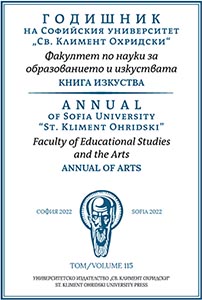ПОСТСЪВРЕМЕННОТО ИЗКУСТВО И ИДЕЯТА ЗА ВИЗУАЛНОТО БЕЗСМЪРТИЕ
POST-CONTEMPORARY ART AND THE IDEA OF VISUAL IMMORTALITY
Author(s): Peter TzanevSubject(s): Fine Arts / Performing Arts, Visual Arts
Published by: Софийски университет »Св. Климент Охридски«
Keywords: visual immortality; contemporaneity; post-contemporary art; transtemporal art
Summary/Abstract: Each historical epoch in art can be described through its specific connection with the idea of immortality. It can be speculated that, in the Western tradition, art is a historically variable concept that functions as a substitute term for visual immortality. The emphasis on the presence of the soul remained a prominent principle of European art for thousands of years. The idea of art as a representation of the soul was followed by the idea of art as a representation of consciousness, which has become a major prototype of the infinite nature of works of art. This process originated in Romanticism but found its ultimate expression in Modernism with the invention of “pure abstraction” and the “white cube” as ideal modern constructions, which represent the absolute models of consciousness. Modernism, Postmodernism and Contemporary art have discovered the idea of visual immortality in different ways. The aim of this article is to show how, in post-contemporary art, the temporality of the visual categories interacts with the idea of visual immortality without replacing it. This article introduces a new art theoretical experiment called “transtemporal art” as a radical form of post-contemporary art.
- Issue Year: 115/2022
- Issue No: 3
- Page Range: 199-220
- Page Count: 22
- Language: Bulgarian

